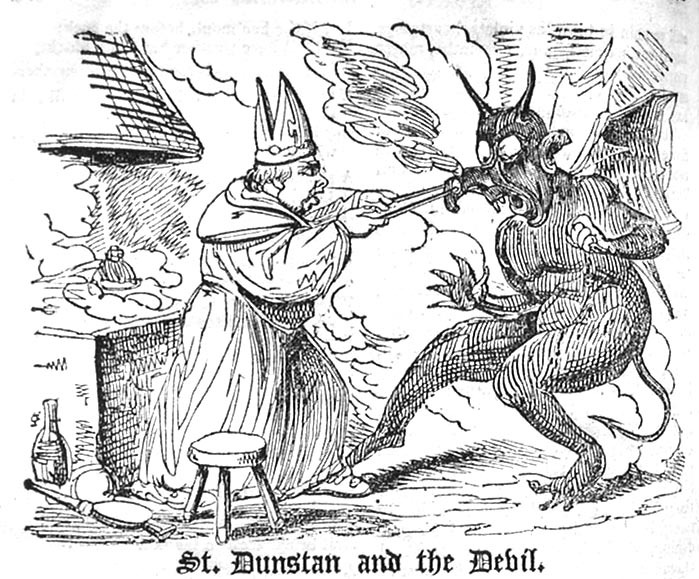May 19.
St. Peter Celestine, Pope, A.D. 1296. St. Pudentiana. St. Dunstan, Abp. of Canterbury, A.D. 988.
St. Dunstan.
He was born at Glastonbury, of which monastery he became abbot, and died archbishop of Canterbury in 988.*[1]
The legend of St. Dunstan relates many miracles of him, the most popular of which is to this effect; that St. Dunstan, as the fact really was, became expert in goldsmith's work; it then gives as a story, that while he was busied in making a chalice, the devil annoyed him by his personal appearance, and tempted him; whereupon St. Dunstan suddenly seized the fiend by the nose with a pair of iron tongs, burning hot, and so held him while he roared and cried till the night was far spent.
There is an engraved portrait of St. Dunstan thus detaining the devil in bondage, with these lines, or lines to that effect beneath; they are quoted from memory:—
St. Dunstan, as the story goes,
Once pull'd the devil by the nose
With red-hot tongs, which made him roar,
That he was heard three miles or more.On lord mayor's day, in 1687, the pageants of sir John Shorter, knt. as lord mayor, were very splendid. He was of the company of goldsmiths, who, at their own expense, provided one of the pageants representing this miracle of St. Dunstan. It must have been of amazing size, for it was a "Hieroglyphic of the Company," consisting of a spacious laboratory or workhouse, containing several conveniences and distinct apartments, for the different operators and artificers, with forges, anvils, hammers, and all instruments proper for the mystery of the goldsmiths[.] In the middle of the frontispiece, on a rich golden chair of state, sat ST. DUNSTAN, the ancient patron and tutelar guardian of the company. He was attired, to express his prelatical dignity and canonization, in a robe of fine lawn, with a cope over it of shining cloth of gold reaching to the ground. He wore a golden mitre beset with precious stones, and bore in his left hand a golden crosier, and in his right a pair of goldsmith's tongs. Behind him were Orpheus and Amphion playing on melodious instruments; standing more forward were the cham of Tartary, and the grand sultan, who, being "conquered by the christian harmony, seemed to sue for reconcilement." At the steps of the prelatical throne were a goldsmith's forge and furnace, with fire, crucibles, and gold, and a workman blowing the bellows. On each side was a large press of gold and silver plate. Towards the front were shops of artificers and jewellers all at work, with anvils, hammers, and instruments for enamelling, beating out gold and silver plate; on a step below St. Dunstan, sat an assay-master, with his trial-balance and implements. There were two apartments for the processes of disgrossing, flatting, and drawing gold and silver wire, and the fining, melting, smelting, refining, and separating of gold and silver, both by fire and water. Another apartment contained a forge, with miners in canvass breeches, red waistcoats and red caps, bearing spades, pickaxes, twibbles, and crows for sinking shafts and making adits. The lord mayor, having approached and viewed the curiosity of the pageant, was addressed in
A SPEECH BY ST. DUNSTAN.
Waked with this musick from my silent urn,
Your patron DUNSTAN comes t' attend your turn.
AMPHION and old ORPHEUS playing by,
To keep our forge in tuneful harmony.
These pontifical ornaments I wear,
Are types of rule and order all the year:
In these white robes none can a fault descry,
Since all have liberty as well as I:
Nor need you fear the shipwreck of your cause,
Your loss of charter or the penal laws,
Indulgence granted by your bounteous prince,
Makes for that loss too great a recompence.
This charm the Lernæan Hydra will reclaim;
Your patron shall the tameless rabble tame.
Of the proud CHAM I scorn to be afear'd;
I'll take the angry SULTAN by the beard.
Nay, should the DEVIL intrude amongst your foes, [Enter Devil.Devil. What then?
St. Dunstan. ————Snap, thus, I have him by the nose!
The most prominent feature in the devil's face being held by St. Dunstan's tongs, after the prelate had duly spurned the submission of the cham of Tartary and the grand sultan, a silversmith with three other workmen proceeding to the great anvil, commenced working a plate of massy metal, singing and keeping time upon the anvil. *[2]
CHRONOLOGY .
1536. Anne Boleyn, queen of Henry VIII., fell a victim to his brutal passions by the hands of the executioner.
1692. The great sea battle off la Hogue.
FLORAL DIRECTORY.
Monk's hood. Aconitum Napellus.
Dedicated to St. Dunstan.
